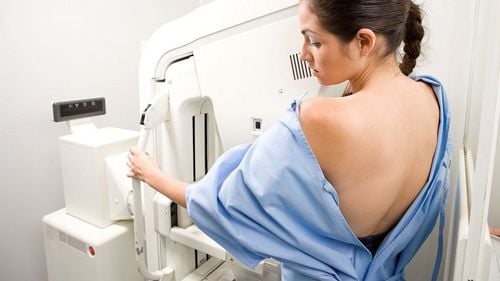This is an automatically translated article.
If you have a small lump in your breast, don't worry too much, because this could be a fibroadenoma, a benign cell proliferation that occurs in young women. The effects of fibroadenomas are very rarely cancerous, but these tumors still have the potential to affect a patient's physical and psychological well-being.
1. What is fibroadenoma?
A fibroadenoma is a benign tumor in the breast. People often confuse fibroadenomas with breast cancer. However, fibroadenomas are different from breast cancer in that they are benign tumor cells that are limited, do not invade other organs in the body, they are limited to the breast tissue. Components of fibroadenoma include mammary gland tissue, fibrous tissue and connective tissue.
Fibrocystic mammary gland tumors are usually classified into 2 types, including:
Simple fibroadenomas: The composition is identical, hardly increasing the risk of breast cancer; Complex fibroadenoma: This type of tumor has many different components, including calcium deposits. If you have this type of lump, your risk of developing breast cancer is 1.5% higher than for other people. The exact cause of fibroadenomas is currently unknown, but researchers suspect hormones play a role in tumor formation. Fibroblastoma is related to reproductive hormones because it usually occurs during the reproductive years. Tumors may get larger when a woman is pregnant or taking hormone therapy. After menopause, along with a drop in hormones in the body, tumors can shrink.
Other causes that contribute to fibroadenomas are taking oral contraceptives before the age of 20.
2. Signs and symptoms of breast fibroadenoma
People with fibroadenomas can feel the lump in the breast when pressing on the skin. Other signs and symptoms of fibroadenomas include:
Firm and well-shaped fibroadenomas; Fibrocystic cysts are usually painless and movable. Fibrocystic tumors can be of different sizes. Most tumors are only about 1-2cm in diameter. Sometimes the patient can't even feel them.
3. Effects of fibroadenomas of the breast
Most cases of patients with fibroadenomas of the breast are not accompanied by dangerous complications. However, in rare cases (range 0.002 - 0.125%), fibroadenomas have an increased risk of developing into malignancies (cancerous). Therefore, doctors always encourage patients to treat if there are any tumors in the body.
The doctor will diagnose fibroadenoma by clinical examination. Depending on your health situation, you may need to have a breast ultrasound or mammogram as follows:
During a breast ultrasound, the patient is asked to lie on a flat surface, then the doctor will use the head device. hand-held probe to reproduce an image of the inside of the breast on a monitor; For mammography, the patient's breast will be compressed by 2 planes to give the most accurate image, from which the doctor can evaluate the current tumor status. To check for a cancerous lump, your doctor may recommend fine-needle aspiration or a breast biopsy. This is a technique that uses a fine needle to poke the breast tissue and take a few small pieces of the tumor to send to a laboratory. Through microscopic examination, the doctor can determine whether it is a tumor or cancer.
4. Can a mother with fibroadenoma breastfeed her baby?
Breast milk is the best source of nutrition for the baby's digestive system, providing adequate nutrients for the baby in the first 6 months of life. When babies pass the first 6 months of life, their energy and nutritional needs will also be greater and breast milk is not enough to meet them, so they need to supplement with other sources of nutrition.
Therefore, breast-feeding with fibroadenoma is a matter of concern for many mothers when encountering this condition. Accordingly, the formation of fibroadenoma does not affect breast-feeding, so if the baby still needs breast milk, you can continue to breastfeed. Breastfeeding will help relieve engorgement and breast discomfort.
5. How to treat fibroadenomas of the breast
Depending on each patient's specific case such as tumor size, health status ... that the doctor will designate the most appropriate intervention method.
Treatments for fibrocystic breast include:
Fibrocystic breast is smaller than 2cm, the patient is painless and does not have any adverse effects on the patient's health, treatment may not be necessary. Doctors often prescribe periodic re-examination, breast ultrasound, mammography and fine-needle biopsies... Large fibroadenoma: In this case, the doctor will consider surgery to remove the entire tumor. . Fibrocystic breast tumors are usually benign, so when a doctor prescribes a follow-up without treatment, you should worry too much, just follow up and periodically re-examine according to the doctor's appointment. As for patients with fibroids who have undergone surgical treatment, maintaining a healthy lifestyle and a scientific diet is extremely important to limit tumor recurrence.
6. Lifestyle habits that help you limit the progression of the disease
You can control fibroadenoma by yourself if you apply the following measures:
Regular check-ups and mammograms according to your doctor's appointment; Do regular breast self-exams at home to check for any abnormalities; Strengthen the body's immune system by exercising regularly; Make an appropriate diet: In the diet, the patient needs to ensure adequate supply of iodine; increase green vegetables and fresh fruits; reduce the intake of red meat, silkworm pupae or duck eggs and foods with high levels of free aluminum and iron in excess of the threshold. In general, breast diseases are very common in women, especially breast cancer - leading in terms of incidence among female cancers. Therefore, if you notice abnormal signs that signal cancer such as breast lumps with little mobility, axillary lymph nodes, abnormal nipple discharge, fever... then visit your doctor for an accurate diagnosis.
Please dial HOTLINE for more information or register for an appointment HERE. Download MyVinmec app to make appointments faster and to manage your bookings easily.













